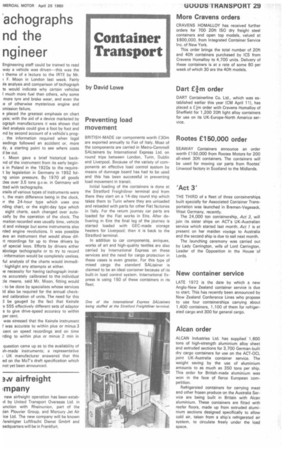Container Transport
Page 31

If you've noticed an error in this article please click here to report it so we can fix it.
by David Lowe
Preventing load movement
BRITISH-MADE car components worth £30m are exported annually to Fiat of Italy. Most of the components are carried in Metro-Cammell SALtainers by International Express Ltd. on round trips between London, Turin, Dublin and Liverpool. Because of the variety of components an effective load control system by means of dunnage board has had to be used and this has been successful in preventing load movement in transit.
Initial loading of the containers is done at the Stratford Freightliner terminal and from there they start on a 14-day round trip which takes them to Turin where they are unloaded and reloaded with parts for other Fiat factories in Italy. For the return journey car parts are loaded for the Fiat works in Eire. After delivering in Eire the final leg of the journey is started loaded with GEC-made storage heaters for Liverpool; then it is back to the Stratford terminal. , In addition to car components, antiques, works of art and high-quality textiles are also carried by International Express on these services and the need for cargo protection in these cases is even greater. For this type of mixed cargo the standard SALtainer is claimed to be an ideal container because of its built-in load control system. International Express is using 150 of these containers in its fleet.
More Cravens orders
CRAVENS HOMALLOY has received further orders for 700 20ft ISO dry freight steel containers and open top models, valued at $800,000, from Integrated Container Service Inc. of New York.
This order brings the total number of 20ft and 40ft containers purchased by ICS from Cravens Homalloy to 4,700 units. Delivery of these containers is at a rate of some 80 per week of which 30 are the 40ft models.
Dart Eim order
DART Containerline Co. Ltd., which was established earlier this year (CM April 11), has placed a £-Im order with Cravens Homalloy of Sheffield for 1,200 20ft light alloy containers for use on its UK-Europe-North America. service.
Rootes E150,000 order
SEAWAY Containers announce an order worth C150,000 from Rootes Motors for 200 all-steel 30ft containers. The containers will be used for moving car parts from Rootes' Linwood factory in Scotland to the Midlands.
'Act 3'
THE THIRD of a fleet of three containerships, built specially for Associated Container Transportation was launched in Bremen-Vegesack, West Germany, recently.
The 24,000 ton containership, Act 3, will join its sister ships on ACT's UK-Australian service which started last month. Act 1 is at present on her maiden voyage to Australia and the second ship is due to sail next month.
The launching ceremony was carried out by Lady Carrington, wife of Lord Carrington, Leader of the Opposition in the House of Lords.
New container service
LATE 1972 is the date by which a new Anglo-New Zealand container service is due to start. This has recently been announced by New Zealand Conference Lines who propose to use four containerships carrying about 1,400 containers, 1,100 of them for refrigerated cargo and 300 for general cargo.
Alcan order
ALCAN Industries Ltd. has supplied 1,600 tons of high-strength aluminium alloy sheet and extruded sections for 3,700 German-built dry cargo containers for use on the ACT-OCL joint UK-Australia container service. The weight saving by the use of aluminium amounts to as much as 350 tons per ship. This order for British-made aluminium was won in the face of fierce European competition.
Refrigerated containers for carrying meat and other frozen produce on the Australia Service are being built in Britain with Alcan aluminium. These containers are fitted with reefer floors, made up from extruded aluminium sections designed specifically to allow cold air, taken from a ship's refrigerated air system, to circulate freely under the load space.
























































































































